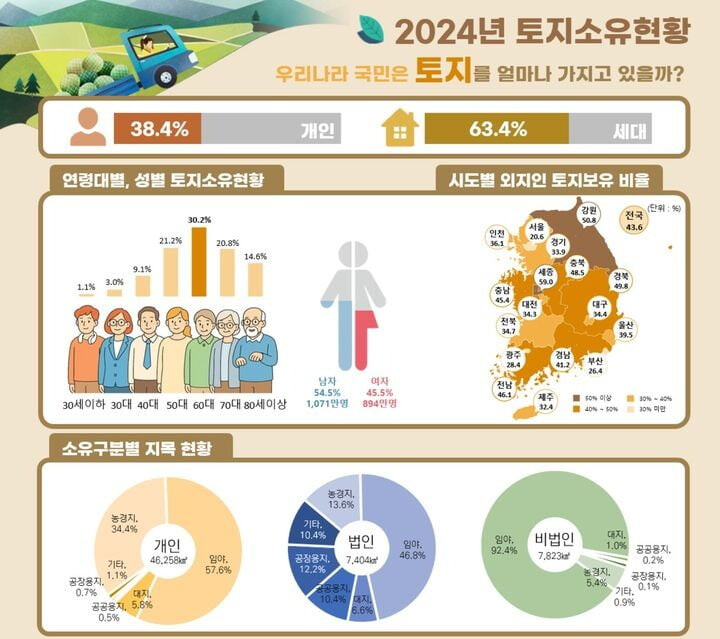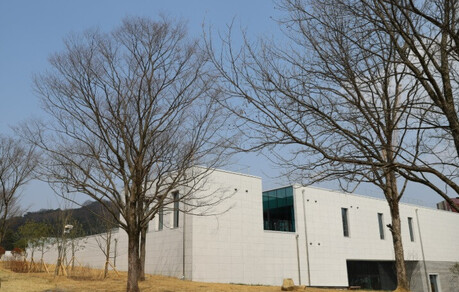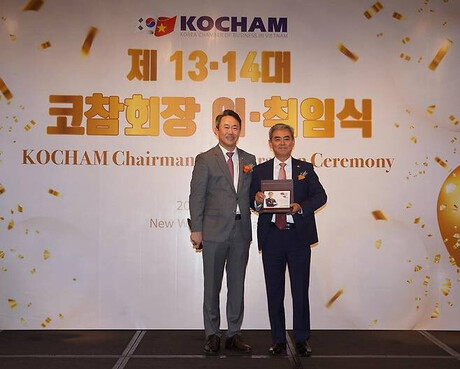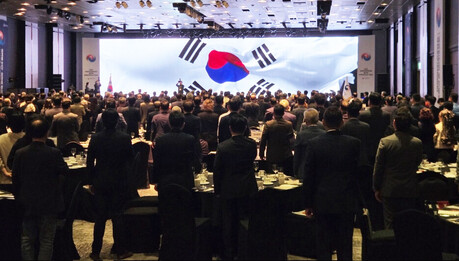
As of the end of 2024, approximately four out of ten South Koreans own land. Notably, over 65% of land owners are aged 60 or above, and the concentration of land ownership among the top 10% is deepening.
According to the '2024 Land Ownership Status Statistics' released by the Ministry of Land, Infrastructure and Transport on July 11, a total of 19.65 million people, or 38.4% of the total registered population of 51.22 million, owned land as of the end of last year. This is an increase of 620,000 people from 19.03 million at the end of 2023.
Accelerated Land Ownership by the Elderly
Looking at the distribution of land owners by age, those in their 60s accounted for the highest proportion at 30.2%, followed by those in their 50s (21.2%), 70s (20.8%), and 80s or older (14.6%). In particular, the proportion of land ownership by the elderly aged 60 or above reached 65.6% of the total. This represents an increase of more than 20 percentage points compared to 45.1% in 2006, when land ownership statistics began to be compiled, clearly showing the aging trend of land ownership in South Korea.
This increase in land ownership among the elderly is intertwined with several socioeconomic factors. As the baby boomer generation fully enters retirement, they often have extensive experience investing in real estate during their asset formation period and tend to prefer land as a stable asset even after retirement. Additionally, the active transfer of land ownership through inheritance is also analyzed as a contributing factor to the increased proportion of land owned by the elderly. This phenomenon may further highlight tax issues such as inheritance tax and gift tax in the future and raises concerns that it could lead to the deprivation of asset formation opportunities for younger generations.
Deepening Land Concentration
The imbalance in land ownership remains serious. When land owners are divided into 10 deciles, the top 10% own 78.4% (36,251㎢) of individually held land. This is an increase from 76.3% in the 2006 survey, indicating a deepening polarization of land assets. For corporations, the top 10% held 92.3% of land, and non-corporate organizations such as Jongjung (clan organizations) and religious groups also showed a high concentration of 68.9%.
This concentration of land in the upper strata is recognized as a social problem as it deepens wealth inequality and can particularly lead to housing market instability. A small number of individuals owning large amounts of land can increase speculative demand for housing supply or delay development, thereby fueling housing price increases. Although the government has pursued various policies, such as strengthening the comprehensive real estate tax and imposing heavier capital gains taxes, to alleviate this concentration, the statistics show that there is still a long way to go.
Land Type Ownership and Out-of-Area Residency Rate
Looking at the land area owned by land type, forest land accounted for the highest proportion. Non-corporate entities owned 92.4% forest land, individuals 57.6%, and corporations 46.8%. This seems to be because forest land was often purchased cheaply or inherited in an undeveloped state in the past.
The average percentage of land owners residing outside the city/province where their land is located was 43.6%. Sejong City had the highest proportion of non-resident owners at 59.0%, while Seoul had the lowest at 20.6%. In the case of Sejong City, it is analyzed that many government and public institution employees purchased land due to the relocation of the administrative capital but actually reside in other areas. In contrast, Seoul has a high population density and a strong tendency for residence and land ownership to coincide, resulting in a low non-resident rate. Criticism is also raised that such out-of-area land ownership is likely to be used for simple speculation rather than contributing to regional economic revitalization.
Household Land Ownership Status
Regarding household land ownership, it was found that 15.30 million households, or 63.4% of the total 24.12 million households in Korea, own land. This is the first time that the number of land-owning households has exceeded 15 million. This signifies that land still accounts for a significant portion of overall assets, including housing. It also shows that despite the increase in the number of households due to factors like the rise in single-person households and nuclear families, the number of land-owning households continues to grow steadily.
Future Outlook and Policy Implications
These '2024 Land Ownership Status Statistics' clearly show that the two major trends in Korean society – aging and deepening asset inequality – are directly reflected in the land market. The increasing proportion of land ownership by the elderly highlights the importance of asset management and inheritance issues after retirement, while simultaneously potentially causing a lack of asset formation opportunities for younger generations. Furthermore, the concentration of land in the upper strata continues to deepen wealth polarization and can destabilize the real estate market, requiring continuous attention and policy efforts from the government.
The Ministry of Land, Infrastructure and Transport plans to incorporate these statistics into land policy formulation through more detailed analysis. Detailed information on land ownership status can be found on the Ministry of Land, Infrastructure and Transport's statistics website and the National Statistical Portal of Statistics Korea. This data will serve as important foundational material for establishing comprehensive land policies, housing supply policies, and tax policies in the future. Now is the time for the government to redouble its efforts to devise land utilization plans suitable for an aging society and regulations for a healthy land market.
[Copyright (c) Global Economic Times. All Rights Reserved.]






























